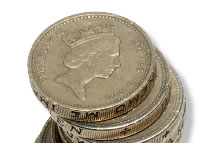 At the end of December 2009, the Police Service of Northern Ireland issued advice to the public following reports that a number of counterfeit £1 coins had been detected in circulation across Northern Ireland.
At the end of December 2009, the Police Service of Northern Ireland issued advice to the public following reports that a number of counterfeit £1 coins had been detected in circulation across Northern Ireland.
The Royal Mint supports this advice and is seeking to correct an inaccuracy that has been reported in the Northern Irish media.
It has been suggested in some reports that £1 coins created in 2008 with heraldic designs that do not have beading (i.e. a ring of small elevated circles around the edge) are counterfeit. This is incorrect.
There were two separate £1 coin designs created in 2008, one with beading and one without. Both are genuine legal tender and not counterfeit. The beading was removed on one version as part of a design initiative.
It may not always be easy to spot a counterfeit pound coin without close inspection. Features to look out for are:
- The date and design on the reverse do not match. The reverse design is changed each year. A list of designs is available here.
- The lettering or inscription on the edge of the coin does not correspond to the right year.
- The milled edge or lettering is uneven in depth, spacing or poorly formed.
- The obverse and reverse designs are not sharp or well defined.
- The coin is unusually shiny and golden in colour for its age.
- The colour of the counterfeit coin does not match genuine coins.
- The orientation of the obverse and reverse designs is not in line.
The Royal Mint takes counterfeiting extremely seriously and undertakes regular surveys to establish the incidence of £1 counterfeit coins. A survey in 2009 indicated a counterfeit rate of around 2.5% across the UK.
Andrew Mills, Director of Circulating Coin Sales at The Royal Mint, says:
‘We need the public in Northern Ireland to be vigilant in helping combat this problem as information is the key route to solving counterfeiting. If people are concerned they have a counterfeit coin, they should check the guidance on our web site. If they are still worried or discover they have a counterfeit coin, it should be taken to a bank, Post Office or reported to local police.’
About The Royal Mint
The Royal Mint is a department of government and its primary responsibility remains the provision of the United Kingdom coinage. Its reputation, however, extends beyond this and internationally it has a reputation for making some fascinating coins for over 100 countries.
The Royal Mint has a history dating back over 1000 years. By the late thirteenth century the organisation was based in the Tower of London, and remained there for over 500 years. By 1812, the Royal Mint had moved out of the Tower to premises on London’s Tower Hill. In 1967 the building of a new Royal Mint began on its current site in Llantrisant, South Wales. In April 1975 the Mint was established as a Government Trading Fund, operationally very similar to a government-owned company.
There were estimated to be 28.2 billion United Kingdom coins in circulation at 31 March 2009, with a total face value of £3.6 billion — all manufactured by the Royal Mint. 1.3 billion United Kingdom coins were issued during 2008-09.





